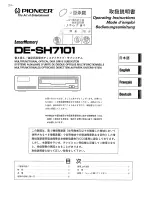
17
Dedicated subwoofer
Dedicated subwoofer
Dedicated subwoofer
Dedicated subwoofer channel
channel
channel
channelssss when using a Meridian 271 Theatre Controller
when using a Meridian 271 Theatre Controller
when using a Meridian 271 Theatre Controller
when using a Meridian 271 Theatre Controller
When the DSW600 is fed with a dedicated subwoofer channel from a non-Meridian surround processor via the
Meridian 271, the channel selector switch must be set accordingly for the input channel of the 271 which the subwoofer
is intended to play.
When a multi-channel input is in use on the 271, each of its 16 channels is fed to the matching numbered output
channel: 1 to 1, 2 to 2, 3 to 3, and so on. These output channels are combined in pairs on the SpeakerLink output
sockets such that each socket carries both channels indicated by the label for the pair. For example, both the upper and
lower sockets below the label “1/2” carry channels 1 and 2.
In addition, the option exists for up to four input channels to be duplicated to the A/B and C/D SpeakerLink output
sockets. Each of these output channel pairs can be configured on the 271 to output a copy of the feed from any of the
eight pairs of input channels, 1/2, 3/4, 5/6 and so on. For example, if A/B is configured to carry channels 3/4, both the
A/B sockets carry channels 3 and 4.
This means that each DSW600 being fed directly from the 271 must have its channel selector set to the appropriate
position for the channel or channels intended to be played:
271 input
271 input
271 input
271 input channel
channel
channel
channel to be
to be
to be
to be played
played
played
played
Switch position
Switch position
Switch position
Switch position
An odd-numbered channel (1, 3, 5, 7, etc.)
1111
An even-numbered channel (2, 4, 6, 8, etc.)
2
22
2
A mix of a pair of channels (1/2, 3/4, 5/6, etc.)
1 + 2
1 + 2
1 + 2
1 + 2
Power status
The
On/Off
On/Off
On/Off
On/Off
switch on the front-panel of the electronics module controls the mains power supply to the DSW600.
When initially powered-up, the DSW600 comes on in
Standby
Standby
Standby
Standby
mode. It is then switched between
Standby
Standby
Standby
Standby
and
On
On
On
On
by
the appropriate communication signals from another Meridian product. These signals are received on the SpeakerLink
input socket of the DSW600 when the rest of the system is switched between
Sta
Sta
Sta
Standby
ndby
ndby
ndby
and
On
On
On
On
.
The power status of the DSW600 is shown by the green LED on the front-panel of the electronics module:
Power status
Power status
Power status
Power status
LED
LED
LED
LED
Off
Not illuminated
Standby
Dimly illuminated
On (Out-of-Standby)
Brightly illuminated
The mains inlet fuse of the DSW600 is located within the circular fuse-holder on the front-panel of the electronics
module. The fuse is designed to protect the product in case of undesired external events, such as a mains power over-
voltage. A spare fuse of the appropriate type and rating is supplied within the accessories supplied with the product.
Controlling the DSW600
Once installed, the DSW600 is intended to work in unison with the other Meridian products in the system. The
subwoofer includes a built-in volume control which remains synchronised with the overall volume level of the system.
This is achieved by communications signals sent over the Meridian comms system carried via the products’
SpeakerLink connections. The volume level of the subwoofer relative to the other loudspeakers in the system can be set
at the time of installation to suit the application.











































